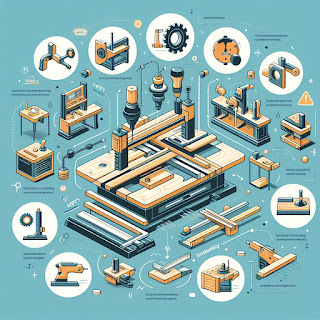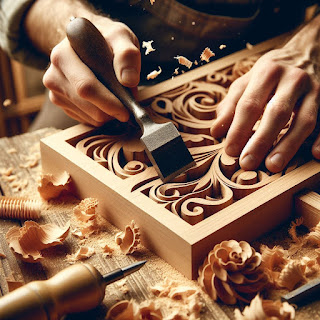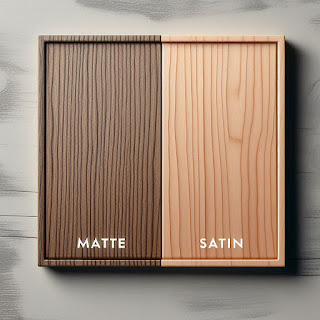Welcome to the fascinating realm of sculptural table-making, where woodworking transcends functionality to become an expression of artistry. In this comprehensive guide, we'll delve into advanced techniques that will enable you to create exquisite tables that serve as captivating centerpieces in any space. From the intricate details of tabletop inlays to the graceful curves of sculptural legs and the mesmerizing allure of marquetry patterns, we'll explore every facet of crafting tables that are as visually stunning as they are functional.
Unveiling the Artistry of Table-Making
Exploring the Intersection of Art and FunctionalityCrafting a sculptural table transcends the mere act of creating a utilitarian object. It involves a meticulous process of embedding one's unique personality and artistic vision into a functional item. This endeavor elevates the table from a simple piece of furniture to an expressive work of art that enhances the aesthetic appeal of any space it occupies. The journey of sculpting a table is marked by thoughtful consideration of form, texture, and material, ensuring that each piece not only serves its purpose but also stands as a testament to craftsmanship and creativity.
Sculptural tables are not just mere pieces of furniture; they are a confluence of artistry and utility. These tables are meticulously crafted to serve their functional purpose while simultaneously acting as captivating centerpieces that elevate the aesthetic of any room. The art of creating such tables involves a deep understanding of both form and function, ensuring that neither is compromised in the pursuit of the other.
The journey of a sculptural table begins with an idea, a vision for a piece that can both fit into the flow of daily life and stand apart as an object of beauty. Designers and artisans who specialize in these tables consider various factors such as material selection, structural integrity, and ergonomic comfort. They often draw inspiration from nature, architecture, or abstract concepts to shape their designs.
Materials play a pivotal role in the creation of sculptural tables. Wood, metal, glass, and stone are commonly used, each bringing its unique texture, color, and strength to the table. The choice of material can influence the table's character—wood may bring warmth and organic lines, while metal can introduce industrial chic or sleek modernity.
The functionality of sculptural tables is as diverse as their designs. Some may serve as statement pieces in a foyer, inviting guests to marvel at their form. Others might be designed for more practical uses such as dining or holding books and decorative items in a living room. Regardless of their use, these tables are always designed with the user's experience in mind.
In today's world, where the line between art and design is increasingly blurred, sculptural tables stand out as exemplary embodiments of this fusion. They challenge the notion that furniture must be purely practical or strictly ornamental. Instead, they offer a harmonious blend that enriches our living spaces with both function and beauty.
As we continue to seek out objects that reflect our personal style and values, sculptural tables answer the call by providing an opportunity to infuse our homes with creativity and elegance. They remind us that even everyday objects can be transformed into extraordinary works of art that not only serve our needs but also inspire our imagination.
Mastering Complex Tabletop Inlays
Overview of Tabletop InlaysTabletop inlays are a remarkable craft that transforms ordinary tables into extraordinary pieces of art. These intricate embellishments are meticulously crafted and carefully inserted into the surface of tables, creating a stunning visual impact. The art of inlay involves embedding pieces of contrasting materials such as wood, metal, shell, or stone into a base structure to form patterns or images.
The process begins with the careful selection of materials, which is crucial as it determines the final appearance and durability of the inlay. Artisans then cut these materials into precise shapes and fit them into carved recesses on the table's surface. This requires a high level of precision and skill, as the inlay pieces must fit perfectly to achieve a smooth, flush finish.
Inlays add depth and texture to tabletops, making them more than just functional furniture. They tell a story, evoke emotions, and reflect the personality of their maker or owner. From simple geometric patterns to elaborate scenes, the possibilities are endless. Each piece is unique, and the complexity of designs can vary from subtle accents to bold statements.
Not only do tabletop inlays enhance the aesthetic appeal of tables, but they also increase their value. A table with beautifully crafted inlays can become the centerpiece of a room, drawing attention and admiration from all who see it. It's an investment in beauty and craftsmanship that stands the test of time.
Whether you're looking to add a touch of elegance to your home or seeking a unique piece that reflects your personal style, tabletop inlays offer an exquisite option. They serve as a testament to the enduring allure of handcrafted artistry in an age where mass-produced furniture is commonplace.
Techniques for Incorporating Complex Inlays
The art of woodworking transcends mere functionality; it's a form of expression that marries utility with beauty. Among the myriad techniques at a woodworker's disposal, the creation of tabletop inlays stands out as a testament to their skill and artistic vision.
Inlay work involves embedding pieces of contrasting materials into the surface of a table to form patterns or images. This intricate process begins with the selection of materials. Woodworkers must choose woods that not only complement each other aesthetically but also possess compatible physical properties to ensure longevity and durability.
Planning is the next critical step. A detailed design must be meticulously mapped out, considering the grain direction, color variations, and the final visual effect desired. This blueprint serves as a guide for the precise cuts that will follow.
Executing these cuts requires a steady hand and an eye for detail. Each piece must fit snugly into its designated space, much like a jigsaw puzzle. The precision of these cuts is paramount, as any gaps can disrupt the seamless appearance of the inlay.
Once all pieces are cut and fitted, they are carefully glued into place. The entire surface is then sanded smooth, making the inlay appear as if it has always been part of the tabletop.
Tabletop inlays are more than just decorative elements; they are narratives told through wood. They reflect the woodworker's journey, from concept to creation, and leave a lasting impression on all who behold them. Such pieces become not just furniture but conversation starters, inviting admiration and curiosity about the story behind their creation.
Crafting Sculptural Legs
Elevating the Aesthetic with Sculptural LegsWhen it comes to the design of a table, legs do more than just hold up the surface; they are a central aspect of the piece's aesthetic and functional appeal. Sculptural legs, in particular, offer a unique opportunity to infuse artistry and statement-making style into furniture design.
The art of sculptural legs lies in their ability to transform the ordinary into the extraordinary. Elegantly tapered forms bring a sense of grace and sophistication, while intricately carved designs can convey intricate stories or representational imagery. The craftsmanship involved in creating these pieces can often be as detailed and painstaking as that of any sculpture in a gallery.
The choice of material also plays a significant role in the impact of sculptural legs. Rich woods can be shaped into fluid curves or sharp, geometric angles, each grain and knot adding to the narrative. Metals, too, offer versatility; they can be twisted into organic shapes or welded into modern, abstract forms.
In essence, sculptural legs are not just supports for a table; they are an expression of creativity and design philosophy. They challenge the notion that furniture must be purely functional and invite us to see everyday objects as works of art.
Techniques for Sculpting Legs
The art of woodworking transcends mere functionality; it is a form of expression that imbues life into the inert. Among the myriad techniques that woodworkers employ, the crafting of sculptural legs for tables stands out as a testament to their skill and creativity. These intricate creations are not just supports for a tabletop; they are the pillars on which the beauty and artistry of the piece rest.
With careful planning and precise execution, woodworkers can shape, carve, and detail sculptural legs to achieve desired forms and aesthetics. The process begins with a vision, a detailed sketch that outlines the curves, contours, and embellishments envisioned by the artisan. Selecting the right type of wood is crucial, as it must possess both the strength to bear weight and the pliability to allow for intricate carving.
The journey from raw lumber to elegant leg involves numerous steps: cutting, shaping, sanding, and finishing. Each step is performed with meticulous attention to detail, ensuring that every curve flows smoothly into the next, every carved detail enhances the overall design, and the final finish brings out the warmth and richness of the wood.
Sculptural legs add not just support but also a touch of elegance and sophistication to tables. They elevate these functional pieces of furniture into works of art that demand attention and admiration. In a world where mass-produced furniture is commonplace, a table with handcrafted sculptural legs stands as a beacon of individuality and craftsmanship.
The structural integrity and stability of these legs are paramount. Woodworkers must balance aesthetic considerations with practicality, ensuring that their creations are not only visually pleasing but also durable and stable. This requires a deep understanding of woodworking techniques and the properties of different types of wood.
Sculptural legs are more than just components of furniture; they are a celebration of woodworking as an art form. They reflect the woodworker's dedication to their craft and their ability to transform ordinary materials into extraordinary pieces that resonate with elegance and artistry.
Embracing Intricate Marquetry Patterns
Understanding MarquetryMarquetry is an art form that transforms ordinary tables into canvases for intricate designs and storytelling. This woodworking technique, which dates back centuries, involves the careful assembly of thin veneers—often made from various types of wood, though other materials like shell or ivory can also be used—to form decorative patterns and detailed scenes.
The process begins with the marqueter selecting veneers with different colors and grain patterns. These pieces are then meticulously cut, often with a fine saw, to fit together like a jigsaw puzzle. The craftsperson must have a keen eye for detail and a steady hand to ensure that the pieces align perfectly, creating a seamless image.
Marquetry can depict anything from simple geometric shapes to elaborate floral arrangements and complex pictorial landscapes. The technique allows for a high degree of creativity and personal expression, as the marqueter can choose from a vast array of veneers to achieve the desired effect. Some artists even dye the wood to create more vivid colors.
Historically, marquetry was a symbol of wealth and status; furniture adorned with these detailed inlays was often found in the homes of the affluent. Today, it continues to be highly valued for its aesthetic appeal and the skill required to produce it.
The beauty of marquetry lies not only in its visual appeal but also in its ability to preserve a piece of history. Each table tells a story, not just through its imagery but through the very wood grains that comprise it—grains that have grown over the years and witnessed the world change. In this way, marquetry tables are more than just furniture; they are timeless pieces of art.
Creating Marquetry Masterpieces
Marquetry is an art form that dates back centuries, a testament to the craftsmanship and creativity of woodworkers who have long understood the value of natural wood. By selecting high-quality veneers—thin slices of wood with unique patterns and colors—craftsmen can ensure that the foundation of their design is both sturdy and visually appealing.
The process of cutting these veneers requires precision and patience. Each piece must be meticulously measured and cut to fit the intended design perfectly. This step is crucial as it determines the fluidity and coherence of the final pattern.
Once the pieces are cut, the skillful assembly begins. This is where the true magic happens, as woodworkers arrange the veneers onto table surfaces, carefully joining them to create stunning marquetry patterns. These patterns are not just decorations; they captivate the imagination, telling stories through their intricate designs and evoking emotions through their natural beauty.
A table adorned with marquetry is more than just a piece of furniture—it's a work of art that showcases the timeless allure of wood. It's a conversation starter, a centerpiece that stands testament to the skill and dedication of its creator. Through marquetry, woodworkers can transform ordinary tables into extraordinary tales of artistry and nature.
Achieving Flawless Finishes and Precise Joinery
Importance of Finishing and JoineryA sculptural table is not just a piece of furniture; it's a work of art that serves both functional and aesthetic purposes. The natural beauty of wood, with its intricate grain patterns and warm hues, brings a touch of nature into our homes. However, to maintain its allure and ensure its durability, a flawless finish is paramount.
The finishing process involves several steps, each crucial to achieving that perfect sheen that not only draws the eye but also provides a protective layer. This layer shields the wood from environmental factors such as humidity, temperature fluctuations, and spills, which can all cause damage over time. A well-applied finish will prevent warping, cracking, and discoloration, preserving the wood's pristine condition.
But beauty is not just skin deep. The structural integrity of a table lies in its joinery. Precise joinery ensures that every joint fits snugly, without gaps or misalignments that could weaken the structure. It's the backbone that supports the table's weight and usage over time. Without it, even the most beautiful table can become wobbly and unstable.
In essence, both a flawless finish and precise joinery are essential for sculptural tables. They enhance the wood's natural beauty while protecting it from damage and ensuring it remains as functional and stable as the day it was crafted. It's this combination of form and function that makes these tables treasured pieces in any home.
Tips for Flawless Finishes and Precise Joinery
Achieving the Pinnacle of Woodworking Craftsmanship: A Guide to Finishes and Joinery
The journey of transforming a simple piece of wood into a work of art is one filled with intricate details and meticulous techniques. For woodworkers, the final outcome is not just about the structural integrity of the piece, but also its aesthetic appeal and longevity. This is where the art of finishing and joinery plays a pivotal role.
Selecting the Right Finish: Harmony Between Wood and Coating
The choice of finish can make or break the visual impact of a wooden table. It's not just about applying a protective coat; it's about understanding the character of the wood and enhancing its natural beauty. From the lustrous depth of varnish to the subtle sheen of an oil finish, each type interacts differently with wood species. A finish should not only protect but also complement the wood, accentuating its grain and color without overpowering it.
Mastering Advanced Joinery: The Backbone of Woodworking
Beyond finishes, the strength and durability of a table lie in its joinery. Advanced techniques such as mortise and tenon, dovetail, and bridle joints are not just functional; they are a testament to a woodworker's skill. These joints, when executed with precision, provide structural integrity and an element of visual interest. They require patience and attention to detail, but the reward is a seamless connection that speaks volumes about the quality of craftsmanship.
The Hallmarks of Quality Craftsmanship
Flawless finishes and precise joinery are indeed hallmarks of quality craftsmanship. They ensure that sculptural tables are not only visually stunning but also capable of withstanding the test of time. It's these details that distinguish a master woodworker from an amateur. By paying close attention to finishing techniques and employing best practices in joinery, woodworkers can achieve impeccable results that are both beautiful and enduring.
Elevating Your Craftsmanship
In the realm of woodworking, sculptural tables stand as a testament to the exquisite artistry that marries form with function. These tables are not mere pieces of furniture; they are objets d'art that elevate any space they inhabit.
The creation of such tables is no small feat—it demands a mastery of advanced woodworking techniques. Tabletop inlays, a method where contrasting materials are expertly embedded into the table's surface, create intricate designs that captivate the eye. Sculptural legs, which may twist and curve in elegant forms, challenge the woodworker's skill in shaping and stability. Marquetry patterns, assembled from small pieces of veneer, showcase detailed scenes or motifs that are as intricate as they are stunning.
Achieving flawless finishes is another hallmark of these masterpieces. It involves multiple stages of sanding, sealing, and coating to produce a surface that not only looks impeccable but also stands the test of time. Precise joinery, the cornerstone of any fine woodworking project, ensures that each component of the table fits together seamlessly, without any hint of the effort involved in its construction.
These tables transcend their utility to become centerpieces of conversation and admiration. By pushing the boundaries of their craft, woodworkers can create tables that are as breathtaking in their beauty as they are functional in their design.
Share Your Masterpieces
Are you ready to embark on your journey towards sculptural excellence? At Dosefornia Furniture, we understand the passion and dedication that goes into creating each unique piece of art. That's why we're here to offer professional guidance, top-quality materials, and the right tools to help you realize your artistic vision. We invite you to share your insights, experiences, and creations in the comments section below. Let's craft beauty together!





































